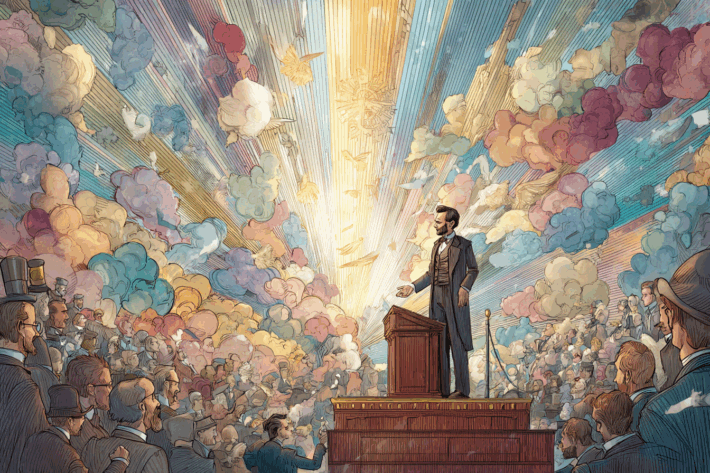Throughout history, certain leaders have stood out not only for their extraordinary achievements but also for the timeless principles that guided their journey. From political titans like Nelson Mandela and Abraham Lincoln to innovative pioneers such as Steve Jobs, their stories offer rich lessons that transcend eras and industries. In today’s rapidly evolving business landscape, marked by uncertainty and fierce competition, these timeless strategies from our greatest leaders can help modern leaders navigate challenges and inspire success.
1. Embrace Visionary Leadership: Nelson Mandela’s Unyielding Hope
Nelson Mandela’s leadership is synonymous with perseverance, vision, and reconciliation. His journey from prisoner to president of South Africa was marked by unwavering determination, and above all, a visionary commitment to unity and justice to set him apart as one of our greatest leaders.
Modern Application:
In business, visionary leadership means articulating a clear, compelling future that motivates teams. Like Mandela, effective leaders must maintain focus on long-term goals despite short-term setbacks. Today’s leaders often confront disruptive technologies and shifting market demands; a clear vision provides the compass to adapt strategically without losing direction.
Key takeaways:
- Cultivate resilience and hope even during hardship.
- Lead with a purpose that resonates emotionally with your team.
- Prioritize unity and collaboration to build inclusive workplace cultures.
2. Humility and Empathy: Abraham Lincoln’s Grounded Approach
Abraham Lincoln, often regarded as one of America’s greatest presidents, was notable for his humility, empathy, and ability to listen. He led the nation through its most divisive period—the Civil War—by fostering dialogue and understanding among conflicting parties.
Modern Application:
In today’s business environment, leaders who show genuine empathy and humility foster trust and loyalty. Empathetic leadership enhances employee engagement and promotes a culture of open communication. Lincoln’s example reminds leaders to value diverse perspectives and resolve conflicts through diplomacy rather than dominance.
Key takeaways:
- Practice active listening and understand employee concerns.
- Admit mistakes and learn from them to build credibility.
- Use empathy to bridge divides and build cohesive teams.
3. Innovation and Relentless Pursuit of Excellence: Steve Jobs’ Passionate Drive
Steve Jobs revolutionized technology and business with his obsession for innovation and perfection. His leadership style emphasized simplicity, creativity, and an uncompromising commitment to quality, which turned Apple into an iconic brand.
Modern Application:
Businesses today operate in an innovation-driven economy where creativity can be a key differentiator. Jobs’ approach encourages leaders to foster environments where experimentation is valued and excellence is the norm. It also highlights the importance of aligning product design with customer experience to drive brand loyalty.
Key takeaways:
- Encourage bold experimentation and risk-taking.
- Focus relentlessly on customer needs and experience.
- Maintain high standards and a passion for quality.
4. Strategic Communication: Winston Churchill’s Persuasive Oratory
Winston Churchill’s leadership during World War II exemplified the power of strategic communication. His ability to inspire, rally a nation, and articulate difficult truths was critical to Britain’s resilience.
Modern Application:
In business, leaders must communicate clearly and persuasively—especially in crises. Transparency and authenticity build trust, while inspiring narratives galvanize teams toward shared objectives. Churchill’s example underscores that how leaders say things can be as important as what they say.
Key takeaways:
- Communicate consistently and transparently with stakeholders.
- Use storytelling to connect emotionally and clarify vision.
- Address challenges honestly while inspiring confidence.
5. Adaptability and Learning: General Dwight D. Eisenhower’s Flexible Planning
General Dwight D. Eisenhower demonstrated the importance of adaptable strategy and collaborative planning during World War II. His leadership emphasized balancing detailed planning with flexibility to react to changing circumstances and led him to be one of the greatest leaders.
Modern Application:
In fast-changing markets, rigid plans can become obsolete quickly. Modern leaders benefit from Eisenhower’s approach by building agile teams that can pivot and innovate when faced with uncertainty. Collaborative leadership also ensures diverse viewpoints inform decisions.
Key takeaways:
- Develop strategic plans with room for adjustment.
- Foster cross-functional collaboration and inclusive decision-making.
- Embrace continuous learning and improvement.
6. Leading by Example: Mahatma Gandhi’s Integrity and Sacrifice
Mahatma Gandhi’s leadership, rooted in non-violent resistance and profound integrity, exemplifies leading by example. His personal sacrifices inspired a mass movement for India’s independence.
Modern Application:
Leaders today are scrutinized more than ever. Integrity and ethical behavior are crucial for building lasting reputations and trust both inside and outside organizations. Modeling desired behaviors encourages similar standards across teams.
Key takeaways:
- Align actions with words to cultivate authenticity.
- Demonstrate commitment to ethical values even when difficult.
- Inspire through personal example and accountability.
Conclusion
The challenges of modern business leadership may seem unique, but the core principles that led history’s greatest leaders to success remain strikingly relevant. Vision, empathy, innovation, communication, adaptability, and integrity form the foundation of timeless leadership strategies. By studying and applying lessons from figures like Nelson Mandela, Abraham Lincoln, Steve Jobs, and others, today’s leaders can better navigate complexity, inspire their teams, and achieve sustainable success.
The true mark of a great leader lies not only in their achievements but in their capacity to learn from the past while boldly shaping the future. History’s greatest leaders provide a roadmap—one that modern leaders would do well to follow.

